Review: Samsung Galaxy S7 Active for AT&T
Jun 14, 2016, 4:00 PM by Eric M. Zeman
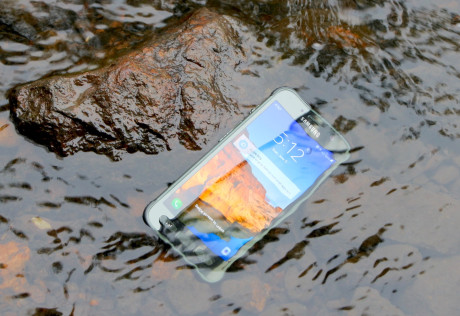
Samsung's latest semi-rugged smartphone for AT&T dials back the good looks of the Galaxy S7 in favor of a stronger, studier frame. The S7 Active is tough enough to take a tumble without the brick-like bulk of some fully rugged handsets. This Android phone also delivers excellent battery life. Here is Phonescoop's full review.
Hardware
Is It Your Type?
The Galaxy S7 is one of the best smartphones you can buy, but it's not for everyone. The glass-and-metal design is slim and attractive, but also somewhat fragile. The S7 Active packages the S7's features into a tougher, more resilient piece of hardware that can handle the abuses many phones suffer day in and day out. If you spend more time outdoors than in, or simply want a phone more apt to make it through your next business trip/vacation, the Samsung Galaxy S7 Active is a top contender.
Body
The S7 Active is not a super-rugged device like those from Kyocera; think of it more like a Galaxy S7 embedded in a really good case.
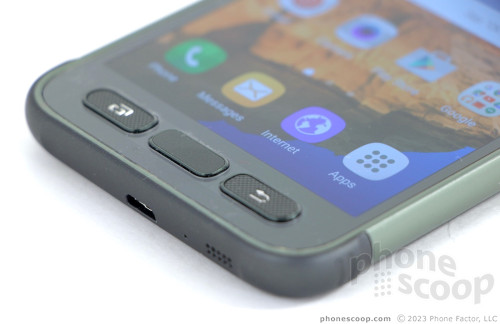
Finding the balance between strength and design is often a game of give-and-take. I don't think there's any question that the Galaxy S7 is a brilliant piece of hardware, but this comes at the cost of durability. The dual glass surfaces mean the phone is twice as likely to break when dropped, shattering not only the glass but your heart.
At the other end of the spectrum, you have something akin to the Kyocera DuraForce XD. You can run over the XD with your car or drop it down a set of concrete stairs and not damage it, but dang if it ain't big and a bit ugly.
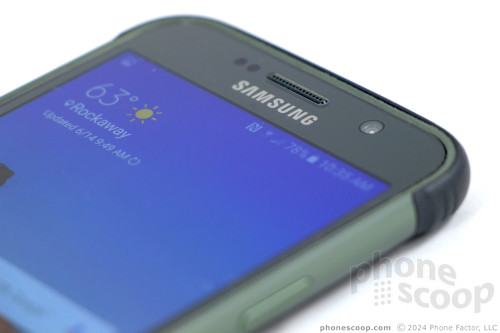
For those Game of Thrones fans, the S7 is Ser Jaime Lannister, while the DuraForce XD is Gregor "The Mountain" Clegane. The Galaxy S7 Active is somewhere in the middle, perhaps Tormund Giantsbane.
Samsung ditched the rear glass surface and stuffed the S7 Active's beautiful screen into a thick(er) metal chassis with rubber corners and a polycarbonate rear shell. The Active is bigger, heavier, and less attractive than the S7, but far stronger. For example, the S7 Active is about 20% heavier.
The tougher, weightier chassis is certified mil-spec 810G for protection from drops, temperature extremes, and dirt/sand. The phone carries over the S7's IP68 rating for protection from water. I dropped the phone, kicked it, let it sit in the sun for a few hours, and left it in the river near my home to test these features. The S7 Active held up without a scratch.
Even though the phone is larger than the standard model, it's still fairly svelte. There are plenty of bigger, heavier phones out there (e.g., Apple iPhone 6s Plus) that aren't ruggedized. The S7 is compact enough to use in one hand most of the time and it should fit into most pockets without trouble. You will feel it in your pocket, and I found the rubber corners sometimes caught the lining of my pockets.
The materials are great. The glass, metal, rubber, and plastics are all top notch. Few phones feel this solid and strong. There's absolutely nothing cheap about the S7 Active, and it has been assembled tightly.
The phone's design is busy all around, including the front face. The metal frame forms a noticeable rim around the glass for protection. The glass is tinted green, black, or beige to match the color of the body. Our review unit is the green camo job and horizontal green lines run side-to-side, giving the non-display areas of the glass a reflective, metal sheen. Three physical buttons are positioned below the screen: multitask, home, and back. The three buttons are the same size and shape, but have different textures. For example, the home button (which doubles as a fingerprint sensor) is smooth, while the multitask and back buttons have distinct textures to help set them apart. The travel and feedback of all three buttons is excellent. The buttons and the speaker grille above the display are color-matched to the rest of the phone. (On the standard S7, these elements would be chrome.)
The green on green on green coloring gives the S7 Active a bit of a muted look. The same is true of the gray model; the beige model is brighter.
About 80% of the left and right side edges of the S7 Active are formed by metal. Rubber bumpers wrap fully around the bottom and top edges of the phone.
The left side houses the volume toggle and textured user-programmable action key. The volume toggle is a slender, smooth button with a generous profile. The action key is smaller, but its profile is a hair bigger. I was able to find and use both buttons with no problem; action and feedback is fantastic. The screen lock button, positioned on the right edge, is similar to the action key in that it is small and has a raised profile. It offers excellent travel and feedback, too. The combo SIM/memory card tray is tucked into the right edge. It is a solid tray that holds the SIM card on one side and the memory card on the other.
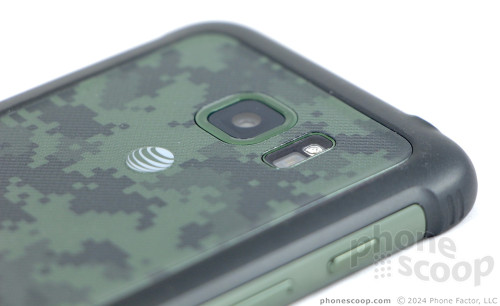
One thing I love about the Galaxy S7 is that Samsung was able to waterproof the phone without hatches and ports. That means the USB port and headphone jack are exposed, but won't let water into the phone's inner cavities. It's a wonder Samsung was able to do this on a handset to slim. The S7 Active has a USB port on the bottom and headphone jack on top and, like the standard S7, both are protected. Microphones are placed on both the top and bottom edges, made visible thanks to the pinhole opening. Samsung drilled some holes in the bottom edge to allow sound to escape the speaker.
The rubber that forms the top and bottom end-caps wraps around the back edges of the phone, framing out the polycarbonate panel that forms most of the rear surface. The rubber is thick, leaving the rear panel sunken in a millimeter or so. I like the coating on the panel, which has a gel-like feel to it. Samsung placed the camera module near the top, with the LED flash and heart rate monitor.
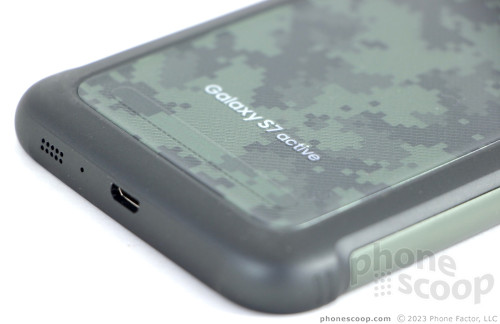
You cannot remove the rear cover of the phone and cannot access the battery. The S7 Active — like the S7 and S7 Edge — is sealed up tight. This might annoy some people, but I think most will be able to live with it.
It may not be much of a looker, but the Samsung Galaxy S7 Active is a sturdy, well-made phone that stands up to rough treatment and unexpected swims. That Samsung was able to create such a tough phone without the brick-like design of other rugged handsets is a bit of a wonder.
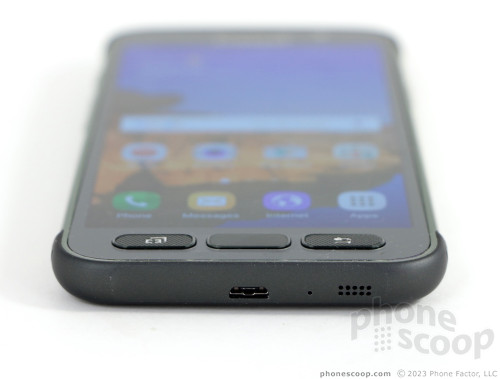
Screen
Samsung says the S7 Active's 5.1-inch quad HD display is more resistant to breakage than the standard model, but didn't say how. I held the Active next to the standard model and could not see any differences between the two screens. The Super AMOLED display is lovely. The resolution density is about as high as it gets, with 3.67 million pixels adorning the display at 576ppi. The S7 Active offers one of the sharpest displays available. I found it to be nice and bright, without the overly garish color representation that's typical of Samsung phones. That means it's more accurate. I didn't have any trouble using it outside, and viewing angles were excellent. The phone includes wet-finger tracking, which means it can be used when wet. I was even able to use the touch screen while the phone was sitting underwater.
Signal
The S7 Active runs swiftly on AT&T's LTE network. Tested around the NYC and San Francisco metro areas, it performed on par with other AT&T devices. Calls connected on the first dial without fail and the phone didn't drop or miss any calls. I was able to make phone calls in all coverage conditions, weak and strong. On the data side of the equation, the S7 Active was quick to download apps, load web pages, and scroll through image-heavy apps such as Facebook and Instagram. It produced excellent peak speeds, surpassing 50 Mbps on occasion.
Sound
Voice calls sound very good via the S7 Active. Voices in the earpiece were plenty loud, enough so to overcome most typical spaces in which you might find yourself (home, office, car). Voices sounded clear for the most part to my ears, but there was some distortion from time to time. Volume and clarity were well matched. Those I spoke to through the S7 Active said I was loud and clear.
The speakerphone maintains a good volume level, and clarity drops just a little bit. I was able to hear calls via speakerphone in the car, outdoors, in my home, and so on. The speakerphone was a bit more prone to distortion than the earpiece, but not in an egregious way.
Ringers and alerts are incredibly loud and were always able to get my attention. The S7 Active's vibrate motor is much stronger than the standard S7's vibrate motor, which means I was more apt to notice it.
Battery
The Galaxy S7 Active provides upgraded battery life thanks to the huge 4,000 mAh battery. It has 33% more capacity than the battery of the standard S7. Aside from the rugged exterior, the battery is the only significantly altered specification difference between the two phones. The power cell pushes the S7 Active well past a full day and deep into a second. I consistently enjoyed 36 hours of battery life with heavy use. Times when I used the phone sparingly saw it last for two days. Few phones can claim to offer as much battery life as the Galaxy S7 Active.
Even so, the S7 Active includes the typical set of Samsung power management tools. Samsung's Power Saver mode and Ultra Power Saver mode each offer distinct benefits. The former tones down the screens, notifications, and the processor to drum up a bit more life from the battery. The latter puts the phone into ultra basics mode with a greyscale screen and severely limits apps to push through hours of basic communications. With a full charge, putting the S7 Active into Ultra Power Saver mode can deliver more than a week of battery life.
The S7 Active supports Quick Charge 3.0 and rapid wireless charging. When plugged into the included charger, I found the S7 Active charged from 10% to 50% in about 20 minutes, and from 50% to 100% in 80 minutes. Wireless charging (using a dual-standard charger) took a bit longer at close to 3 hours.
Bluetooth, GPS, NFC, WiFi
Samsung gave the S7 Active all the same radios found in the standard S7 and they all behaved in a normal fashion.
I was very happy to use the NFC radio to help pair the S7 Active with a new set of stereo Bluetooth headphones I recently purchased. It was a snap: just tap and connect. The NFC radio can also be used to support Samsung/Android Pay.
The Bluetooth radio itself did a great job. It connected to headsets, headphones, my car, and PCs with ease. Phone calls sent to headsets sounded pretty good and music sent to my new headphones sounded excellent.
Together with Google Maps, the S7 Active was able to pinpoint my location in two blinks of an eye. Accuracy was as good as 20 feet, which is very hard to beat. It ran smoothly as a navigation tool and I relied on it to direct me around San Francisco via BART and foot.
The WiFi radio was very quick.
Software
Editor's Note: The Galaxy S7 Active may look different from the Galaxy S7, but it has the exact same processor, RAM, camera, and other core components. It also runs the same version of Android and has the same build of Samsung's TouchWiz UI and apps. Therefore, we've carried over portions of the text below from our review of the Galaxy S7. Rest assured, we fully tested every feature of the S7 Active for AT&T.
Lock Screen
Samsung took a page from some of its competitors when it comes to the lock screen. The biggest and most important change is the inclusion of an "always on" screen that shows the date, time, battery level, and core notifications from email, messaging, and the phone. This way you can snag a quick status update without pressing any buttons or waking the phone up. It's truly helpful. Like the Lumia Glance Screen, the S7 Active's status tool floats around the display sort of like an old-school screen saver. Nostalgia!
Other than this change, the lock screen works mostly as it does on every other Android smartphone. Pressing the home button or screen lock button will fully wake the display and you'll see the time, date, notifications, and several app shortcuts. I like that you can customize how much detail is revealed by the individual notifications. (If you care to burrow deep into the settings menu you can tweak exactly how each app is allowed to notify you.) The lock screen includes shortcuts to the phone app and camera. You can't customize the app shortcuts, which is a bit of a shame.
The physical home button doubles as a fingerprint reader. That means you can use your fingerprint to secure the phone. I trained several prints and found it to be mostly reliable. It's not quite as quick as the print readers on the iPhone 6s or HTC 10, but it is quick enough for daily use. Other security options include patterns, PINs, and passwords, which can be set to switch on immediately or after a specified interval. Choose wisely.
Home Screen
The Galaxy S7 runs Android 6.0 Marshmallow. That means it includes some of the core new features from Google, such as Doze and Now On Tap. As expected, however, Samsung plastered its TouchWiz UI on top of the base platform. The results are mixed, but not all that different from any other phone Samsung has released in recent memory.
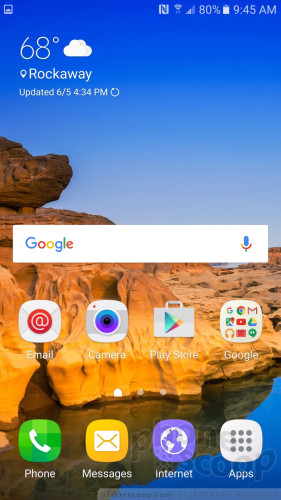
There are three home screen panels active out of the box and they are filled with an assortment of Samsung and AT&T apps and services. It takes some effort, but you can clear away the junk and customize the home screen panels with the apps, shortcuts, and widgets of your choosing. I like that Samsung allows you to assign which panel is the home panel, such as the middle screen or left-most screen, etc. You can activate the Briefing panel (which is Flipboard) if you want, or ignore it. If activated, Flipboard automatically becomes the left-most panel.
One thing I dislike: the button to access the app drawer is anchored to the far right of the home screen dock. I prefer the button to be in the middle, but Samsung won't let you move it around. Worse, the dock only fits four buttons across where many phones fit five buttons. Oddly, you can adjust the size of the home screen panel grid between 4x4, 4x5, or 5x5 icons, depending on how many apps you want on each screen. Doing this, however, doesn't change the 4-icon limit in the dock. C'mon, Samsung!
As for the app drawer, Samsung organizes it into horizontal panels. Out of the box, there is a single panel that has a handful of folders jammed with AT&T, Samsung, and Google apps. Samsung normally allows users to choose between alphabetical order, custom order, or order based on frequency. If you choose alphabetical order, which is what I prefer, all of the apps are pulled out of folders and listed individually. On the S7 Active, choosing the alphabetical arrangement doesn't pull the folder-bound apps out. This is really annoying to me. You can take the time to individually remove the folders. These are small complaints, I suppose, but the S7 Active is harder to tweak in this regard than the GS6 or other Samsung phones.
There is no change to how Samsung treats the settings screens. You can choose to add some of your most-used settings tools to the top of the screen; otherwise, all the settings are arranged into the usual clumps (radios, personalization, accounts, system, and so on.) The same goes for the Quick Settings panel and notification shade. Samsung changed up the fonts, colors, and icons, but the underlying functionality of the Quick Settings panel is unchanged. That means you can tweak where the toggles land for controlling various radios, and such.
When it comes to personalization, the S7 Active includes an expanded set of themes. Themes override everything: fonts, colors, icons, graphics, wallpapers, and more. There is only one alternate theme preinstalled on the phone. If you want more, you'll have to create a Samsung account to download them. That's annoying and pretty much guarantees I won't be downloading more themes. Creating a Samsung account is free, and most of the themes are free, too. The usual tweaks are all available, such as ringers, alerts, yadda yadda yadda.
You can multitask on the S7 Active by running two apps at the same time in separate windows. Not all apps are supported, but those that are have a distinct icon (two rectangles on top of one another) to indicate their compatibility with the tool. It works fine and takes maybe 60 seconds to master.
The S7 Active includes TouchWiz Easy Mode, which gets rid of the complicated home screen panels and app drawer in favor of larger icons and fewer screens through which to navigate. This tool is meant for people who may be new to smartphones, or those who have seriously bad eyes.
You can use a number of different hand gestures to control the phone. For example, you can capture a screenshot by swiping the edge of your hand across the display, or call the contact whose call log, message, or contact details are on the screen by bringing the phone to your ear. Incoming calls can be muted by placing your hand on the screen or turning the phone over.
On the performance front, the S7 Active has a Snapdragon 820 processor with 4 GB of RAM. The 820 is Qualcomm's top-of-the-line chip, and 4 GB is a whole lot of RAM for a phone. The 820 is a SoC that bundles together blazing quick processor cores with a GPU, ISP, and LTE radios. It's fast. The phone does everything lickety split. You won't see any staggering, slowness, or lagging with the S7 Active. It performed every task I set before it without hesitation.
Camera
The camera app is a carry-over from older Samsung phones, but has a wider array of shooting modes and tools than most. The best way to launch the camera is to double tap the home button. You can do this when the phone is locked. You may also program the action key in the left edge to open the camera if you wish. The camera jumps to life quickly so you can capture a shot.
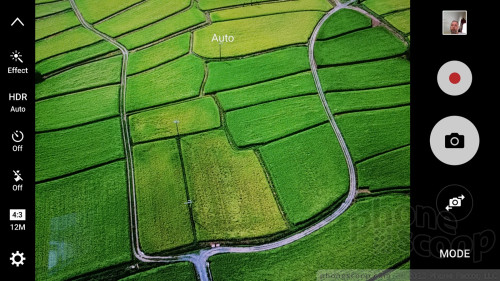
The S7 Active's camera includes shutter controls and access to the shooting modes and recent photos on the right side of the viewfinder. There are two shutter buttons, one for pictures and one for video, and the shooting modes include auto, pro, selective focus (bokeh), panorama, video collage, live broadcast, slow motion, virtual shot, food, hyperlapse, aqua (for underwater shots), tag shot, and sports. None of these modes is really new. I'd recommend most people stuck with the auto settings, as it is the easiest to use, and takes great photos.
The “pro” mode is a manual mode that adds control over white balance, exposure, and ISO, which are not available on the auto mode. You can choose your own shutter speed, too, up to 10 seconds for creative night shots, as well as fiddle with metering and color correction. Select focus allows you to alter which subject is in focus after you've taken the photo. The video collage tool automatically assembles a handful of photos and videos (based on time, location) to create shareable moments. Live broadcast lets you push live video directly to YouTube. The Food tool lets you take close ups of your fancy food and makes the colors look more vivid. Slow motion and hyperlapse do what you expect them to. The virtual shot tool lets you take 360-degree images of stationary objects. For example, you can use it to walk around Michelangelo's statue of David and then see the statue from all sides on your phone. It's tricky to use and takes practice.
Using the aqua shooting mode uses software to account for the fact that the phone is under water. It also rewires the controls a bit: the action key becomes the shutter button, and the volume key becomes the video button. The tag shot mode is chiefly for adding GPS location data to images, while the sports mode improves focusing and shutter speeds in order to help freeze motion.
An arrow on the left side of the camera UI will drop down a set of icons that let you access effects (sepia, etc.), the timer, flash, HDR, and full settings. You can play with the resolution, location tags, grid lines, and so on, but there are a few more-advanced settings. For example, you can turn on the Motion Photo capture mode, which captures video and images at the same time (like HTC's Zoe and Apple's Live Photos). It works well. The S7 Active also has a tracking auto-focus feature that lets you select a subject and keep it in focus even if it moves around.
The user-facing camera includes several imaging tools. The basic selfie mode includes a beautification tool that's rather extensive. For example, you can make your face slimmer, make your eyes bigger, add a heavenly shine to your face, as well as play with your skin tone. The selfie came includes a wide-angle mode to fit more people into that group shot, and you can use the live broadcast function when taking selfies, too. Last, the camera will snap pictures in selfie mode if you cover the heart-rate monitor with you finger.
The camera app is very fast. The Snapdragon 820 — along with its dedicated image signal processors and Samsung's software — provide flawless performance of the app itself. You can keep it simple for basic photography if you want, or take advantage of the wide number of features to more creative. It's got something for everyone.
Photos
Samsung took a different approach to the camera sensor this year. For a while it seemed as though Samsung might fall victim to the megapixel wars, amping up the number of pixels indefinitely in order to appear more powerful. But photo pros know that megapixels aren't everything, and that has apparently sunk in with the folks over at Samsung. That's why the S7 Active trades the 16-megapixel sensor from the S6 Active for a higher-quality 12-megapixel sensor. Samsung says the pixels are larger to improve low-light capture, among other advantages.

The phone takes darned good pictures. It's probably the best camera available from a modern smartphone, and it definitely goes toe-to-toe with the iPhone 6s, HTC 10, and LG G5.
Focus is sharp, exposure is dead-on, and colors are accurate. I was very pleased with the results I saw from the camera. The phone does well in bright and dark environments. Shots taken in darker spots were free of grain and noise. The f/1.7 aperture and optical image stabilization help a lot here. Pictures you take underwater will depend a lot on lighting and luck. It's a fine, fine camera.
The front camera has a 5-megapixel sensor and an f/1.7 aperture and it produces excellent selfies. I find many phones take grainy selfies that look soft and drab. The S7 Active takes highly accurate selfies (warts and all!) that are crisp, clean, and properly exposed. You're going to be able to take your selfie game to a whole new level with the S7 Active.
The phone captures video up to 4K, but as always I recommend you stick with the 1080p HD settings. Full HD provides all the pixels you need and the S7 Active does a great job at delivering sharp, accurate video.
Going on vacation? Leave the dSLR at home. The S7 Active can handle most of your photography and video needs — even if that involves the beach, ocean, or other outdoorsy spot.
Samsung / AT&T Stuff
The AT&T S7 Active has 52 apps pre-installed, which is more than AT&T crammed onto the standard S7. The issue isn't so much the volume of apps as it is how aggressive AT&T's apps are. They assault you during the device setup process and, even when dismissed, come back later with reminders to sign up, download this, install that, sync here, and push there. It's way over the top. AT&T's apps border on malware, they're that intrusive. In particular, the DirecTV app pushes an ever-present advertisement to the notification panel that drives me insane.
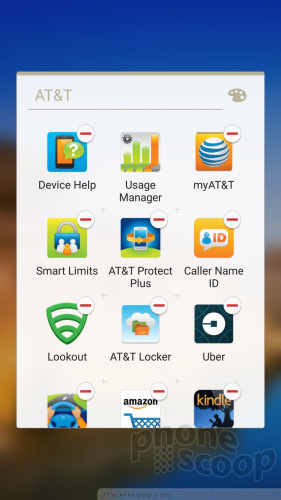
Samsung toned down the presence of its own apps, but there are still 11 Samsung apps hidden in a folder. (S Health, S Voice, Milk Music, and so on.)
The one app from Samsung truly pertinent to the S7 Active is the Activity Zone app. It keeps track of weather and includes a barometer, compass, flashlight, and stopwatch. It is, by default, the app that opens when you press the user-programmable action key. It works, but the design is rather basic.
My biggest gripe with all these is that hardly any of the unwanted apps can be uninstalled. AT&T allows you to "turn off" unwanted apps. This reverts to the installed version of the app and then inactivates them. Apps that have been turned off won't be updated or run, but they'll still take up internal storage space — except for DirecTV. Even when turned off, that app comes back to push its ad into the notification panel.
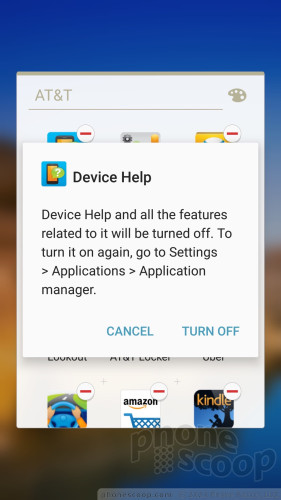
By the way, the phone ships with 32 GB of storage, of which 23 GB is available out of the box. Thank goodness the phone supports 200 GB microSD cards.
Wrap Up
I like the Samsung Galaxy S7 Active a lot — at least as far as the hardware is concerned. If you need something sturdier than your average glass phone, but still want the raw performance of today's best flagship, the S7 Active has everything you need.
The phone is tough but still easy to carry around and use; it's waterproof without annoying hatches/ports; the screen is absolutely top-notch; and the larger battery should satisfy even the most power-hungry users. Voice and data performance are quite good, Qualcomm's Snapdragon 820 is blazing fast, and the camera is one of the best available.
I still dislike Samsung's interface a bit, but Samsung gave the S7 Active an incredible array of tools for personalization. The S7 Active's home screen is a willing canvas upon which you can design the interface of your dreams. AT&T's intrusive bloatware nearly ruins the experience for me. Apps that push ads to notification shade are a major no-no. Sadly, the S7 Active is an AT&T exclusive (Samsung is not yet selling an unlocked version), which means you have no choice but to deal with the AT&T garbage if you buy this phone.
The Galaxy S7 Active is a pricey phone at $795, but if its semi-ruggedization saves you from replacing the phone just once you'll have made back your money. Also consider the cost of the rugged case and extra battery pack you won't need to buy.
If you want the best balance of tough hardware and mobile computing, look no further than the Galaxy S7 Active from Samsung.

Comments
No messages


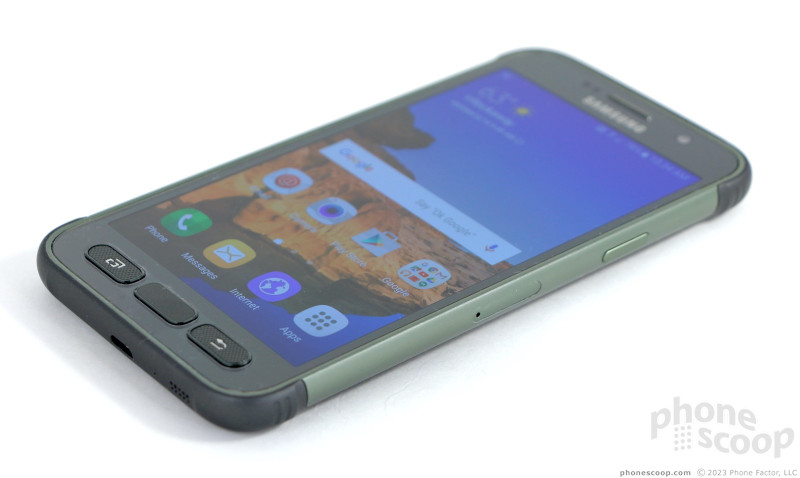













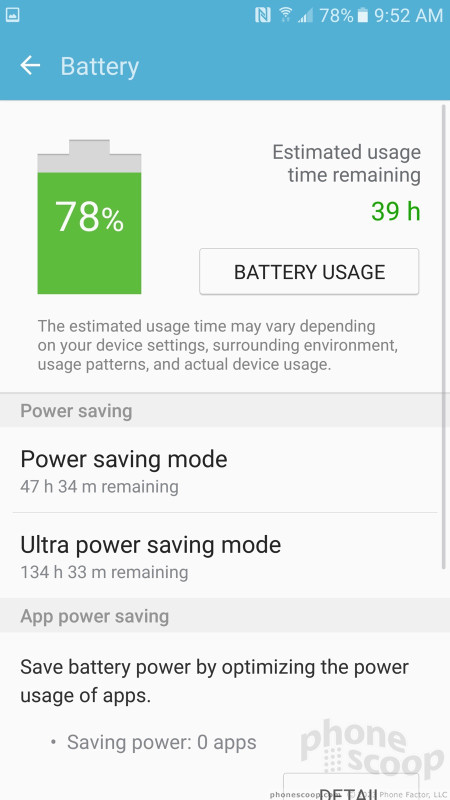




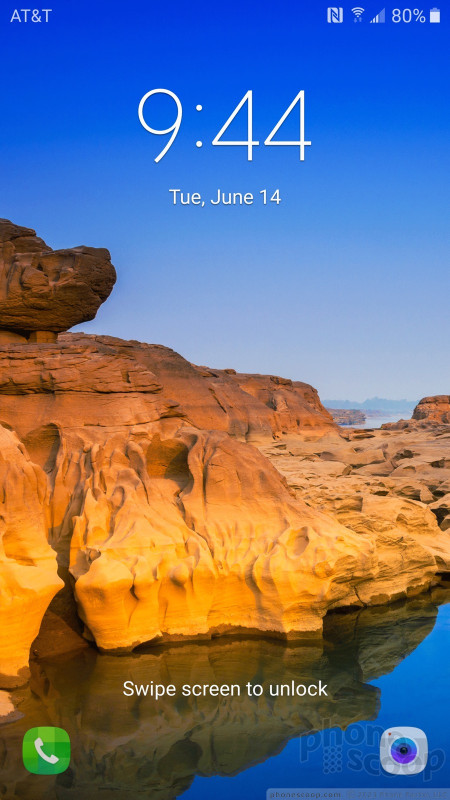





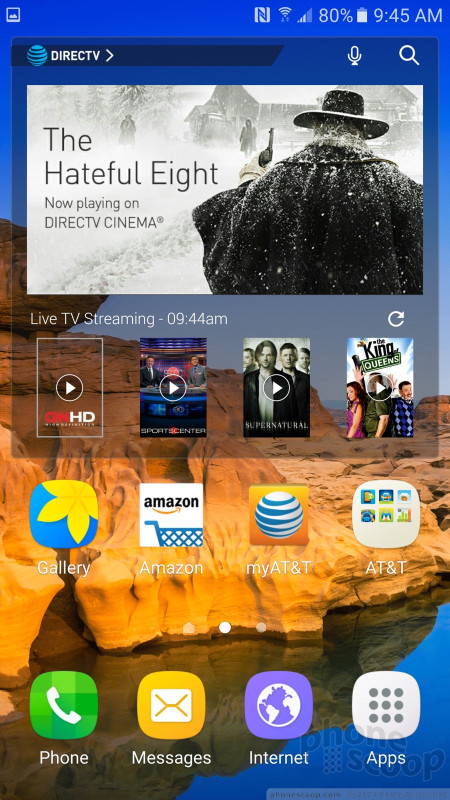






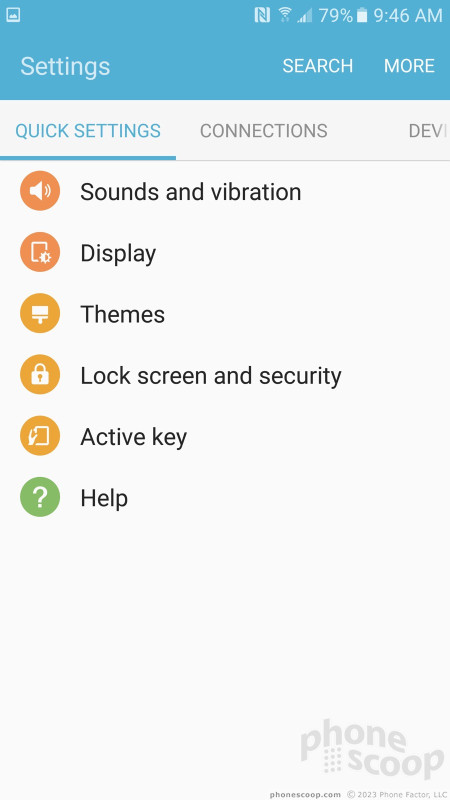





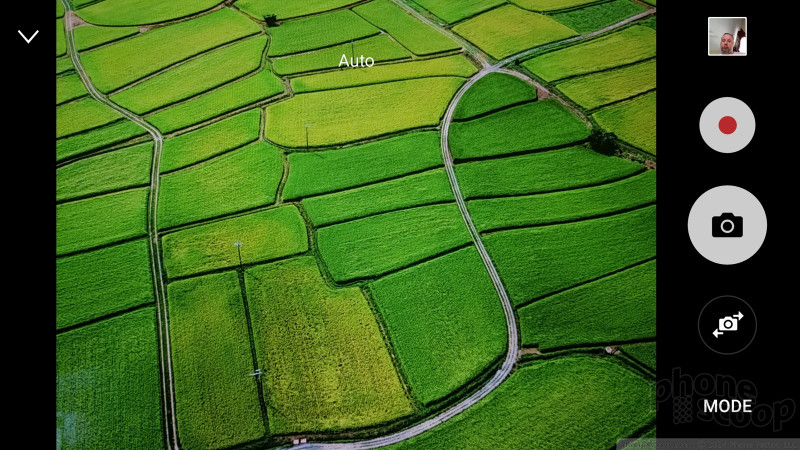


























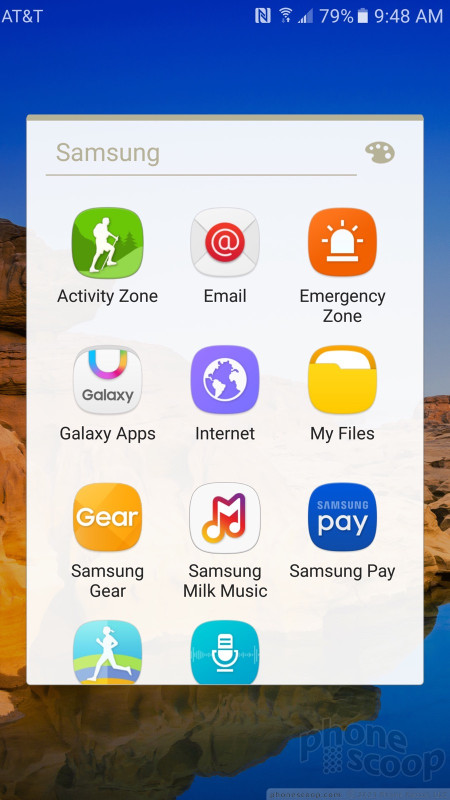




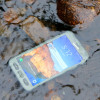 Hands On with the Samsung Galaxy S7 Active
Hands On with the Samsung Galaxy S7 Active
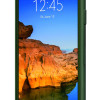 Samsung Galaxy S7 Active Built for the Adventurous and the Accident-Prone
Samsung Galaxy S7 Active Built for the Adventurous and the Accident-Prone
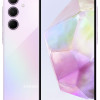 Samsung Expands Mid-Range Lineup with Galaxy A35 5G
Samsung Expands Mid-Range Lineup with Galaxy A35 5G
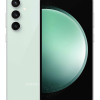 Samsung Brings Back the FE for its Galaxy S23 Series
Samsung Brings Back the FE for its Galaxy S23 Series
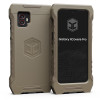 Samsung Brings its Military Phones to First Responders
Samsung Brings its Military Phones to First Responders
 Samsung Galaxy S7 active
Samsung Galaxy S7 active




